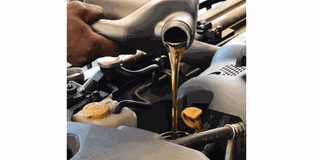Checking oil level; you don’t need a mechanic

With no or low engine oil, a car’s moving parts melt because of the high temperatures and the engine fails. Photo by Edgar Batte.
What you need to know:
Looking under the bonnet has been left to the mechanics at garages, but there are many simple inspections and tasks that drivers should do on a regular basis between visits to the garage, and checking engine oil level is one of them.
The other day, a friend asked me about checking the engine oil level on a car. This is a simple task really, but it was then that I realised there is a whole generation of drivers out there driving cars that are advanced and do not need as much service work as their predecessors.
Lift the bonnet of many cars and all you see are plastic covers. Even under the covers, there is still a maze of stuff covering the engine compartment. Thing is though even with all the coverings, the oil check is quite still visible.
Looking under the bonnet has been left to the mechanics at garages, but there are many simple inspections and tasks that drivers should do on a regular basis between visits to the garage, and checking engine oil level is one of them.
Here’s the thing, an engine has a zillion moving parts at high temperatures. These moving parts are grinding and moving against each other hence friction, this is where engine oil comes in to lubricate the movement.
O-Level physics teaches us that friction causes heat, so with no or low engine oil, these moving parts literally melt and mash up because of the high temperatures and the engine instantly fails.
A typical passenger car engine will contain between four and six litres of oil. Many of them hold about four and a half litres. When the engine is turned off, the oil drains down into the oil pan.
It is recommended checking the oil level either before turning on the engine in the morning, or five to 10 minutes after shutting it down so you can have all the oil in the oil pan to get an accurate measurement.
The dipstick
Finding the dipstick is quite easy. It is a long piece of metal sticking out of the engine with a loop at one end, usually located near the centre of the engine. Many times it will be labelled with the word “Oil” or brightly coloured yellow.
The stick usually has at least two marks on it.
So how would you actually check the oil level? Well after the engine is ready and the car parked on a relatively levelled surface, pull on the loop and draw the dipstick all the way out.
Wipe the oil off the dipstick with a rag or anything equivalent. Replace the clean dipstick, making sure to push it all the way in, then pull it back out and hold it horizontally in front of you.
Look at the pointy end of the dipstick. Many dipsticks simply have two marked lines.
The oil level should be halfway between these two lines. Some more over-elaborate designs have points for low, ok, over fill, add etc.
Too much oil
Too much oil in the engine can cause problems where by the oil can’t be pumped properly throughout the engine. Consequently parts can’t be lubricated properly and this can cause engine damage. When you notice this, you ought to take your car in for fixing immediately.
Low oil level
When the oil level is low on the dipstick, the engine is usually down about one litre of oil. It is still ‘‘ok” to drive with this level, but quick turns, hard acceleration or braking can cause the oil to move to one side and uncover the oil pump pickup. Air is sucked into the lubrication system and the engine bearings lose lubrication for a few seconds. Do this enough times and you will damage the engine, so it is better to keep the oil level closer to the full mark.
If there is no oil on the dipstick, the engine is more than two litres low and you may have already done some engine damage.
Oil light monitors
Some drivers believe that their oil level must be good because the oil light has not come on. They might be remotely right to some extent. But the oil light monitors oil pressure, not level.
Most oil lights will come on if the oil pressure drops and this drop in pressure is caused by a number of things where low oil is just one of them.
If the oil light comes on because of a sudden loss of oil, and you should shut the engine off without delay saving the engine. However, if the oil pressure drops because the oil level in the pan has been gradually getting lower, the engine will likely be damaged by the time the light comes on.
Checking the oil level every so often is a preventive maintenance trick that costs nothing, and is extremely important if you are travelling long distances. It virtually can save you an engine.




